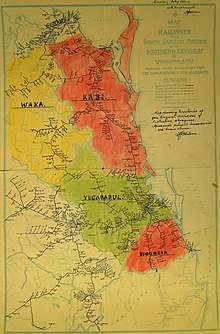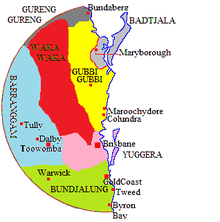Jagera people
The Jagera people, also written Yagarr, Yaggera, Yuggara,Yuggera, Chepara-Yuggara, Chepara-Yugara, Ugarapul, Yugarabul, Yuggarapul, and Yugarapul (pul-People that speak Yug[g]ara) are the Australian Aboriginal people who are the Traditional Owners of the territories from Moreton Bay to the base of the Toowoomba ranges including the city of Brisbane (including Ipswich). The Turrbal people are of roughly a group from the north of Brisbane, but referring strictly speaking to a Jagera dialect.

This group is one of the traditional custodians of the land over which much of Brisbane is built.
Language
Yaggera is classified as belonging to the Durubalic subgroup of the Pama–Nyungan languages, but is also treated as the general name for the languages of the Brisbane area of which Chepara-Yugarapul people have historically been considered a dialect.[2] The Australian English word 'yakka' (loosely meaning 'work', as in 'hard yakka') came from the Jagera language (yaga, 'strenuous work').[3]
The Yaggera language was identified in Petrie on page 319 of his "Reminiscences" recorded by his daughter Constance, by the traditional language identifier, the word for "no". Their association with central Brisbane is established by the word for Brisbane, being recorded by Petrie as "Mianjin".[4] Mianjin is the spike of land from North Quay to Breakfast Creek, and was also known, as was the tribe there, as Miguntyun.[5]
Ludwig Leichhardt's Diaries 1842-1843 recorded Miguntyun as "Megandsin" as the name for the land holding area from Brisbane CBD to Breakfast Creek, and the people who spoke the Yuggara Yugarabul language.[6]
Country
This group is one of the traditional custodians of the land over which much of Brisbane is built.[7]
According to Watson, the Jagera-related peoples in the Chepara tribe inhabited the territories from Moreton Bay to Toowoomba to the west, nearly to Nanango in the north west, including Brisbane and Ipswich.[8] It also encompasses Jimna and its surrounding forests, where their traditional lands adjoined those of the Wakka Wakka and the Gubbi Gubbi (also Kabi Kabi or Gabi Gabi). Subgroups of the Chepara have identified with distinct areas including those concentrated in the Fassifern and Lockyer Creek areas. The Yugambeh and the Bundjalung people bordered them on the south.[9]
An Indigenous Land Use Agreement (ILUA) was signed over the site of the historic 1843 Battle of One Tree Hill, now known as Table Top Mountain, when the warrior Multuggerah and a group of men ambushed and won a battle with settlers in the area. The ILUA was signed between Toowoomba City Council and a body representing the "Jagera, Yuggera and Ugarapul people" as the traditional owners of the area, in 2008.[10][11]
On 25 July 2017, the full bench of the Federal Court decided on appeals of the Turrbal People and the Yugara People, rejecting both appeals and confirming the 2015 decision that native title does not exist in the greater Brisbane area.[12][13][14][15]
Place names

- Meebatboogan, Mount Greville, Moogerah Peaks National Park.
- Cooyinnirra, Mount Mitchell, Main Range National Park.
- Booroongapah, Flinders Peak, Flinders Peak Group.
- Ginginbaar, Mount Blaine, Flinders Peak Group.
Notable people
- Multuggerah, 19th-century warrior
- Uncle Desmond Sandy[16]
- Aunty Ruth James[16]
- Aunty Pearl Sandy[16]
- Uncle, Hon. Neville Bonner, former Australian senator, was a Jagera tribal elder.[17]
- Auntie Jeannie Bell, Australian linguist.[18]
- Auntie Faye Carr, 2017 National NAIDOC Awards Winner Female Elder of the Year[19][20][21]
- Latia Schefe, 2017 National NAIDOC Awards Winner Youth of the Year[19][22][21]
- Susan, originally Bunjoey, daughter of Moonpago.[23][24]
Notes
Citations
- Watson 1944.
- Dixon, Ramson & Thomas 2006, p. 42.
- Dixon, Ramson & Thomas 2006, p. 209.
- Petrie & Petrie 1904.
- The Queenslander 1934, p. 13.
- Erdos 1967, pp. 102–104.
- Howitt 1904.
- Crump 2015.
- Steele 2015, p. 85.
- "Indigenous land use agreement signed in Toowoomba". 27 February 2008. Archived from the original on 11 February 2014.
- "QI2007/038 - Jagera, Yuggera and Ugarapul People and Toowoomba Regional Council". Register of Indigenous Land Use Agreements Details. National Native Title Tribunal. 19 September 2008. Retrieved 5 August 2020.
- Singleton & Testro 2017.
- CCW 2017.
- Carseldine 2017.
- NNTT 2015.
- AustLII 2015.
- Rolls & Johnson 2010, p. 38.
- Russo 2015, p. 215.
- Queensland Govt 2017.
- Morelli 2017.
- Zhou 2017.
- ABC News 2017.
- The Courier-Mail 1947, p. 2.
- The Telegraph 1936, p. 11.
Sources
- "Aboriginal Language". The Queenslander. Brisbane. 18 January 1934. p. 13. Retrieved 27 October 2017 – via Trove.
- Bell, Edin (1946). Legends of the Coochin Valley. Bunyip Press – via Trove.CS1 maint: ref=harv (link)
- Carseldine, Amy (18 September 2017). "Negative determination of native title over Brisbane upheld". Crown Law (Queensland Govt). Retrieved 31 October 2017.CS1 maint: ref=harv (link)
- Crump, Des (16 March 2015). "Aboriginal languages of the Greater Brisbane Area". Aboriginal and Torres Strait Islander Languages. State Library of Queensland. Retrieved 31 October 2017.CS1 maint: ref=harv (link)
- Dixon, R. M. W.; Ramson, W.S.; Thomas, Mandy (2006). Australian Aboriginal Words in English: Their Origin and Meaning (2nd ed.). Oxford University Press. ISBN 978-0-195-54073-4.CS1 maint: ref=harv (link)
- Erdos, Renee (1967). Leichhardt, Friedrich Wilhelm Ludwig (1813–1849). Australian Dictionary of Biography (2: 1788–1850 I-Z ed.). Melbourne: Australian National University. pp. 102–104. ISBN 0-522-84236-4.CS1 maint: ref=harv (link)
- "Full Federal Court determines native title does not exist over a large part of greater Brisbane". Corrs Chambers Westgarth. 26 September 2017. Retrieved 31 October 2017.
- Howitt, A. W. (Alfred William) (1904). The native tribes of South-East Australia. Robarts - University of Toronto. London: Macmillan.CS1 maint: ref=harv (link)
- "Last of Her Tribe-- Ugaraphul Princess Buried At Coochin". The Telegraph. 30 May 1936. p. 11. Retrieved 19 May 2017 – via National Library of Australia.
- Meadows, Michael (2001). Voices in the Wilderness: Images of Aboriginal People in the Australian Media. Greenwood Publishing Group. ISBN 978-0-313-31566-4.CS1 maint: ref=harv (link)
- "Mills takes out Person of the Year at NAIDOC Awards". ABC News. 2 July 2017. Retrieved 3 July 2017.
- Morelli, Laura (3 July 2017). "This Yuggera Grandmother of 47 scores Female Elder of the year award at NAIDOC". NITV. Retrieved 3 July 2017.CS1 maint: ref=harv (link)
- Petrie, Constance Campbell; Petrie, Tom (1904). Tom Petrie's reminiscences of early Queensland (dating from 1837). Cornell University Library. Brisbane: Watson, Ferguson & co.CS1 maint: ref=harv (link)
- "QCD2015/001 - Yugara/YUgarapul People and Turrbal People". National Native Title Tribunal. 16 March 2015. Retrieved 31 October 2017.
- "Queenslanders Honoured at National NAIDOC Awards". Queensland Government. 1 July 2017. Retrieved 3 July 2017.
- Rolls, Mitchell; Johnson, Murray (2010). Historical Dictionary of Australian Aborigines. Scarecrow Press. ISBN 978-0-810-87475-6.CS1 maint: ref=harv (link)
- Russo, Katherine E. (2015). "Semantic Change: Intersubjectivity and Social Knowledge in the Sydney Morning Herald". In Calabrese, Rita; Chambers, J. K.; Leitner, Gerhard (eds.). Variation and Change in Postcolonial Contexts. Cambridge Scholars Publishing. pp. 209–227. ISBN 978-1-443-88493-8.CS1 maint: ref=harv (link)
- Sandy on behalf of the Yugara People v State of Queensland (No 2) [2015] FCA 15 (27 January 2015), Federal Court (Australia).
- Singleton, Scott; Testro, Nick (26 July 2017). "Full Federal Court confirms native title does not exist over greater Brisbane". King & Wood Mallesons. Retrieved 31 October 2017.CS1 maint: ref=harv (link)
- Steele, John Gladstone (2015). Aboriginal Pathways: in Southeast Queensland and the Richmond River. University of Queensland Press. ISBN 978-0-702-25742-1.CS1 maint: ref=harv (link)
- "This Week'S Book Reviews". The Courier-Mail (3168). Brisbane. 18 January 1947. p. 2. Retrieved 19 May 2017 – via National Library of Australia.
- Watson, F. J. (1944). "Vocabularies of four representative tribes of South Eastern Queensland: with grammatical notes thereof and some notes on manners and customs, also, a list of Aboriginal place names and their derivations". Journal of The Royal Geographical Society of Australasia. Brisbane. 48 (34). OCLC 682056722. Retrieved 31 October 2017 – via Trove.CS1 maint: ref=harv (link)
- Zhou, Naaman (1 July 2017). "Naidoc awards: Dianne Ryder, Ollie George and Patty Mills among winners". The Guardian. ISSN 0261-3077. Retrieved 3 July 2017.CS1 maint: ref=harv (link)